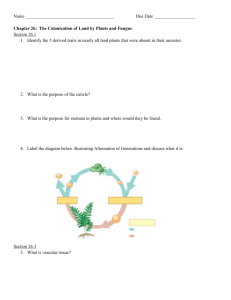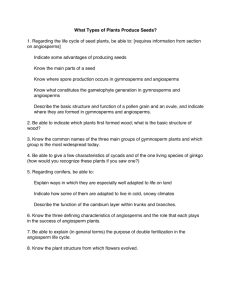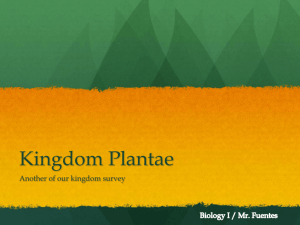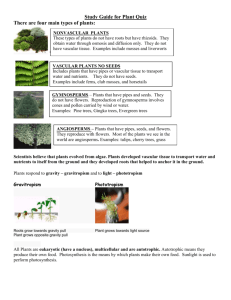3.2: The Plant Kingdom pg. 96 Non-vascular Plants: Bryophytes
advertisement
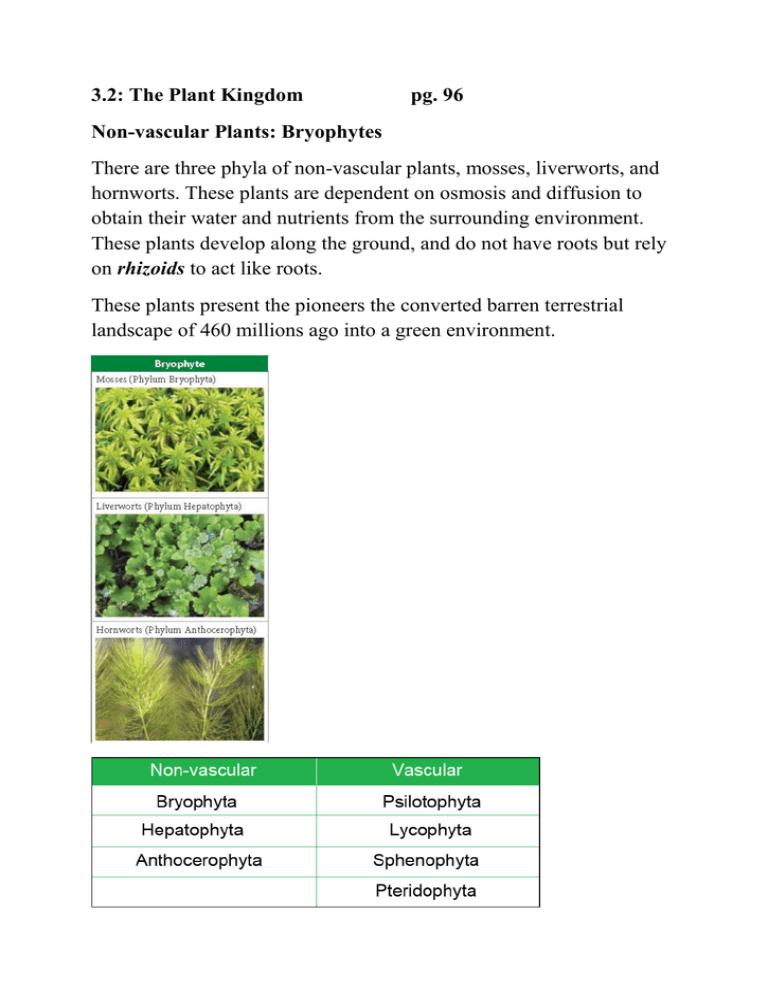
3.2: The Plant Kingdom pg. 96 Non-vascular Plants: Bryophytes There are three phyla of non-vascular plants, mosses, liverworts, and hornworts. These plants are dependent on osmosis and diffusion to obtain their water and nutrients from the surrounding environment. These plants develop along the ground, and do not have roots but rely on rhizoids to act like roots. These plants present the pioneers the converted barren terrestrial landscape of 460 millions ago into a green environment. Seedless Vascular Plants Ferns formed the first forests about 350 million years ago. These seedless vascular plants were different from the non-vascular plants. They developed vascular tissue which also allowed them to grow tall, greater then a metre in height. Table 3.2: Features of Seedless Vascular Plants pg. 98 Seed-producing Vascular Plants: Gymnosperms and Angiosperms Gymnosperm: a vascular plant with non-enclosed seeds. Angiosperm: a vascular plant with seeds enclosed in a protective tissue. There are two groups of plants that disperse by seeds, gymnosperms and angiosperms. Seeds allow plants to reproduce sexually, without needing water and are protected from harsh environments. The seeds can survive without water for many years, they can be dispersed by different means across continents. The first seed bearing plants first appeared about 280 million year ago. Gymnosperm Diversity Gymnosperms (naked seeds) have seeds that are exposed on the surface of cones. Cone bearing trees (conifers), such as; pines, firs, yew, spruce, cedar, and redwood. (A) Coniferous trees produce seeds on the surface of cone scales, making them a target for animals such as birds. (B) Cycadophytes are short, palm-like trees with scaly trunks, but they are not closely related to palms. (C) Ginkgo biloba is the only living species in the ginkgophyte group. Reproduction in Gymnosperms: Cones and Pollen The reproductive structures are cones. Male cones are usually soft and short-lived. The female cone are hard and longer-lasting, made up of scales where the eggs develop. Sexual reproduction in seed plants requires a mechanism to transport sperm from the male cone to the unfertilized egg of the female cone for fertilization. Pollen grains are tiny, reduced gametophytes that travel from the male cone to the female cone. The wind is usually the dispersing method. Angiosperm Diversity Angiosperms, commonly known as flowering plants, are vascular plants. These plants have flowers used for reproduction a fruit, where the seed are contained. 90 % of all plants are angiosperms (250 000 species), roses, trilliums, oaks, maples, and birches. A long with grasses and weeds. Flowering plants first appeared 150 million years ago. Angiosperm Characteristics Flower: collection of structures in angiosperms used for sexual reproduction. Plants that developed many large colourful flowers are dependent on animals for the transfer of pollen, insects collect pollen as they look for food, nectar. Other angiosperms that produce non-colourful flowers are reliant on the wind to disperse pollen. Angiosperms have both male and female housed within the flower, although there are a few angiosperms that have separated male and female plants. Figure 3.14: The typical flower has four organs: sepals at the base, attractive petals, male stamens that produce pollen, and the female pistil that contains the ovary. Fruits Fruit: a mature ovary of a flower that protects and dispersed dominant seeds. Different types of fruit will help support the dispersion of seeds. Fruits eaten by animals will have seeds dispersed when the animal excretes later. Burrs may stick to animal fir and drop off later in different areas. Other seeds may float in water and are washed a shore in different areas, like the coconut. Angiosperm Classification Monocot: a major cluster of flowering plants that have one cotyledon. Dicot: a major cluster of flowering plants that have two cotyledons. Angiosperms are divided into two groups based on their structure of their seed leaf or cotyledon. The cotyledon of the embryo helps to nourish the plant as it starts to grow. Angiosperm embryos can have one (monocot) or two (dicot) cotyledons. Other characteristics expressed by angiosperms; monocots vs. dicots are listed below in Table 3. Table3.3: Differences between Monocots and Dicots. Learning Check: Questions 13 – 18 pg. 101 Section 3.2 Review: Questions 1 – 13 pg. 104


